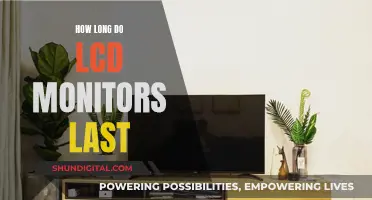
TN stands for twisted nematic, a type of LED panel display technology that is a form of LCD. TN panels are the fastest and cheapest among the other main types of display panels, VA (vertical alignment) and IPS (in-plane switching). TN panels are therefore popular for gaming monitors and laptops. However, they offer the worst viewing angles and colour reproduction in comparison to VA and IPS panels. TN panels are also the oldest type of LCD panel, with limited viewing angles and inferior colour reproduction.
| Characteristics | Values |
|---|---|
| Full Form | TN stands for Twisted Nematic |
| Display Type | TN is a type of LED (a form of LCD) panel display technology |
| Cost | Cheapest among VA and IPS panels |
| Viewing Angles | Worst viewing angles compared to VA and IPS panels |
| Colour | Worst colour compared to VA and IPS panels |
| Refresh Rate | High refresh rate ranging from 100Hz to 144Hz or higher |
| Response Time | Low response time |
| Input Lag | Low input lag |
| Usage | Great for gaming monitors and gaming laptops |
What You'll Learn

TN panels are the cheapest and fastest option, but have poor viewing angles and colour reproduction
TN panels, or Twisted Nematic panels, are a type of LED (a form of LCD) display technology. They are the fastest and cheapest among the other main types of display panels, VA (vertical alignment) and IPS (in-plane switching).
TN panels are known for their fast response times and high refresh rates, making them a popular choice for gaming monitors and laptops. However, this speed often comes at the cost of colour accuracy and viewing angles. TN panels offer inferior colour reproduction, with colours appearing less accurate and vibrant than other technologies. They also have poor viewing angles, with picture quality degrading when viewed from certain angles. This is due to the way the liquid crystal molecules are oriented and the light polarizers are positioned at 90-degree angles.
Despite these limitations, TN panels are an affordable and fast option for those who do not require accurate colour reproduction and wide viewing angles. They are ideal for budget-conscious buyers or those who require multiple monitors. TN panels are also suitable for gamers who value fast response times and high refresh rates for fast-paced games.
While TN panels are a cost-effective and speedy option, they may not be the best choice for professionals or users who prioritise image quality and colour accuracy. If you are a graphic designer, photographer, or anyone who requires precise colour management and wide viewing angles, IPS panels or VA panels may be more suitable alternatives.
Unlocking ASUS Monitor Key Lock: A Step-by-Step Guide
You may want to see also

TN panels are the oldest type of LCD panel
TN panels, or twisted nematic panels, are the oldest type of LCD panel still in use. The technology has been iterated since the original digital watch designs, but the name remains the same. TN stands for twisted nematic, referring to the fact that the molecules of liquid crystal are twisted by 90 degrees between two glass plates.
TN panels are characterised by their fast response times and low cost. They are the cheapest to manufacture and are versatile, with no real-world limits on size, shape, resolution, and refresh rate. This makes them ideal for gaming monitors and laptops.
However, TN panels have their drawbacks. They offer poor colour accuracy, lower brightness, and slower refresh rates than other panel types. They also have notably poor viewing angles, with colour distortion occurring when the screen is viewed from the side.
Despite their limitations, TN panels are still a common choice for budget monitors and laptops. They are a definite improvement on older monitor technology, such as CRT, and their fast response times make them suitable for gaming. However, unless you are looking for a bargain, there are now better alternatives available that offer improved image quality.
Monitoring Internet Usage: Netgear Genie's Parental Controls
You may want to see also

TN panels are good for gaming monitors and laptops
TN stands for twisted nematic, a type of LED (a form of LCD) panel display technology. TN panels are the fastest and cheapest among the other main types of display panels, VA (vertical alignment) and IPS (in-plane switching).
TN panels are ideal for gaming monitors and laptops because they offer high refresh rates and low response times, resulting in minimal motion blur and low input lag. These features make them perfect for fast-paced gaming action. Additionally, their affordable price point makes them accessible to a wider range of gamers.
However, it's important to note that TN panels have some limitations. They offer inferior colour reproduction compared to VA and IPS panels, and their viewing angles are not as good. This means that the picture quality can degrade when viewed from certain angles.
Despite these drawbacks, TN panels remain a popular choice for gamers due to their speed, responsiveness, and affordability.
Monitoring KWH Usage: A Simple Guide to Energy Tracking
You may want to see also

TN panels have the lowest input lag
TN stands for twisted nematic, which is a type of LED panel display technology and a form of LCD. TN panels are the fastest and cheapest among the other main types of display panels, VA (vertical alignment) and IPS (in-plane switching). They are characterised by their low response times, high refresh rates, and minimal motion blur.
While TN panels are the fastest, they also offer the worst viewing angles and colour reproduction when compared to VA and IPS panels. IPS panels, for example, tend to be slower but offer wider viewing angles and superior colour reproduction. VA panels aim to fill the gap between TN and IPS panels.
If you're an ultra-competitive gamer, a TN panel is recommended. However, if you prefer better image quality over faster response times, then an IPS panel might be a better choice.
Monitoring Kids' Online Activity When Using Hotspot
You may want to see also

TN panels are unsuitable for photo editing
Firstly, TN panels have poor colour accuracy. They are typically 6-bit, which means they can only display 262,144 colours, whereas 8-bit panels can display 16,777,216 colours, and 10-bit panels can display over 1 billion colours. This limited colour depth means that TN panels cannot display the full 24-bit true colour spectrum and must use interpolation to simulate colours, resulting in visible colour banding and lower-quality contrast ratios.
Secondly, TN panels have poor viewing angles, especially on the vertical axis. Looking at a TN panel from an extreme angle can cause colours to invert, which can be distracting and make it difficult to accurately assess the colours in a photo.
Thirdly, TN panels have high response times and input lag, which can make them less ideal for photo editing software, which often requires precise and responsive inputs.
Finally, TN panels are not as advanced as other panel types, such as IPS and VA. They are the oldest version of LCD panels and are therefore not as commonly used anymore, especially for photo editing, where colour accuracy and viewing angles are crucial.
While TN panels may be sufficient for daily use or gaming, where response time and input lag are more important, they are not suitable for photo editing, where colour accuracy, viewing angles, and advanced features are required.
Karaoke Monitor Size: Choosing the Best Display for Your Needs
You may want to see also
Frequently asked questions
TN stands for twisted nematic.
TN is a type of LED (a form of LCD) panel display technology. TN panels are the fastest and cheapest among the other main types of display panels, VA (vertical alignment) and IPS (in-plane switching).
TN panels offer the worst viewing angles and colour reproduction when compared to VA and IPS panels.







